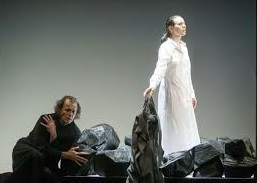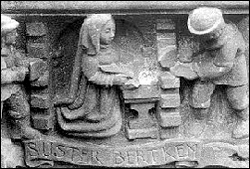Suster Bertken

Suster Bertken is an opera based on the life and writings of the 15th-century anchoress from Utrecht. It was premiered on December 4th 2010 at a Zaterdagmatinee concert in the Amsterdam Concertgebouw. Soprano Katrien Baerts performed the title role, along with baritone Hubert Claessens, boy-sopranos James Dugan and Leopold Benedict, and the ASKO/Schönberg Ensemble conducted by Reinbert de Leeuw.
What fascinates me in Suster Bertken’s writings, is the curious discrepancy between the limited space in which they were conceived and the immeasurable distances covered in the visions described in them. In that respect Suster Bertken is a kind of 15th-century counterpart to the British scientist Stephen Hawking, who is confined to a wheelchair but whose thoughts fan out to the furthest reaches of the universe. With this difference, of course, that Hawking’s confinement is involuntary.

It is tempting to speculate on why Suster Bertken chose her own ‘worldly death’,
the more so because historical data relating to her choice are virtually absent.
Had her great love finally proved out of reach? Or was it because she was a bastard
child? Suster Bertken herself gives cause to such speculations: ‘It caused me many
a grief’, and ‘Ah, that it is full of deceit I have always been aware’, she sings
in The World, the second movement which follows the instrumental opening.
But although it can do no harm to try and search for the underlying motives for
a person’s actions, psychologizing can sometimes divert the attention from what
is most obvious and in her case most difficult to understand: Her enclosure was
based on her own volition. This was the life she wanted to lead. Minimum freedom
of movement, maximum devotion and imagination. That it cannot be a very unhealthy
way of life may be deduced from the fact that she lived in her cell from when she
was about thirty until her death at the age of 87.
An enclosure was accompanied by a ritual. A priest, usually the Bishop, said a
Requiem Mass. A woman, who renounced the worldly life formally died and was therefore
consciously present at her own burial. The priest would then ask a number of questions
inquiring after the intentions of the aspiring anchoress, and if they were answered
in the affirmative she disappeared into her cell forever. In my Requiem
the ceremony is performed by Prior Dirck van Malsen, the man who held the keys to
Bertken’s cell.
Reading Suster Bertken’s Kersttractaet (Christmas Tract) was what really
won me over, and it also showed me how the piece was to take shape from then on.
The Tractaet tells the story of the birth of Jesus, but seen from the
Virgin Mary’s perspective. The Holy Virgin begins to tingle and to be transparent,
floating up from the soil before shooting upwards like a rocket into the sky, past
angel’s choirs, to the very highest. There, as in a flash, she sees God and faints.
At that moment the delivery takes place, painlessly: ‘like an arrow that slides
through the air, and is neither hindered nor obstructed by the air, nor is the air
injured by the arrow’. Gently the angels lower her down to earth again where she
regains consciousness when the baby Jesus cries. The text of the Tractaet
gives rise to a circular motion in the piece from a freely desired worldly death
to an imaginary birth. The text, moreover, is vibrant with the fervent longing for
a child and links up perfectly, and remarkably, with Nietzsche’s observation that
it is all women’s deepest wish to give birth to the Uebermensch.
The fourth movement, A wonderful sound came to me, is an intermezzo with
a markedly meditative character, in which I have tried, as much as possible, to
melt instrumental music and singing together. It forms a bridge between the
‘worldly noises’ of the previous movements and the leap into the divine in the
rest of the piece. In the Raising up to heaven, the fifth movement, the
text of the Kersttractaet begins. It is interesting to see how the
increasingly ecstatic character of the text gives rise to a process of identification.
It may start as a fairly neutral story about Mary, but in the sixth movement The
sweet, gentle child Jesus, one begins to suspect that it is rather Suster
Bertken’s own breasts that give succour to the Redeemer. The birth of Jesus
coincides with the death of Suster Bertken. In the final movement Hodie mecum
eris in paradiso He sings, in the form of two boy sopranos, to his mother
in words that foreshadow his own death on the cross.
Rob Zuidam, December 2010
translation: Helene Reid
